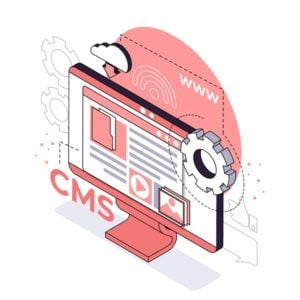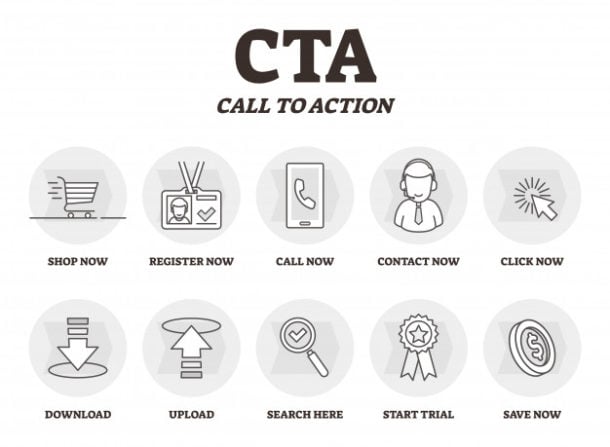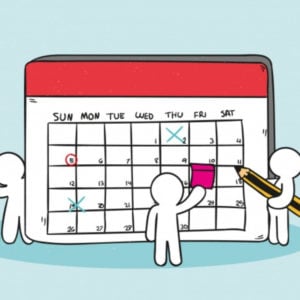Ultimate Blogging Tips For Beginners That Actually Work
Are you looking to increase sales? Do you want to connect with your customers? Is being an industry leader important to you?
If you said ‘yes’ to any of the above questions then you may want to consider blogging.
When blogging first began it was mainly for individuals who wanted to share things about their lives with others, but today it has become an integral part of owning a business.
But how do you create a blog?
We’ve highlighted all the key points to get you started quickly, but let’s first identify exactly what blogging is and its benefits.
What is a blog?

A blog is a platform that can help build an online presence, draw leads, and engage an audience. It’s also a collection of editorial content based on a central theme that demonstrates industry expertise. For example, a catering service might write blog posts such as, “The 10 Best Desserts to Serve to a Crowd” or “Stress-Free Dinner Parties: Recipes that are Made Ahead of Time.”
Blogs can drive traffic to your website, transform that traffic into leads, help you gain authority in your industry, and eventually expand your business. In reality, organizations are 13x more likely to see good ROI by prioritizing blogging.
Getting Started
Before you start blogging make sure that you know exactly why you want to start a blog. Once you know the reason it will become much easier to identify your goals and objectives.
Why are you starting a blog:
- Just for fun?
- To support other people?
- To promote an established business and add content to the website?
- To share your expertise on a specific subject?
- To start work in your home business?
- To extra money online?
Write a brief “Why” statement for your blog. Writing a “Why” statement will help you decide the main purpose and help you make better choices for your blog in the future.
Get ideas out of your audience
Develop blog posts that address the most important questions from people you’re talking to on social media.
This can be a great way to come up with ideas about the topics that people would most like to read, which will help your blog thrive! One of the effective ways we’ve seen this in action is through Tweets or blog comments.
Designing and Creating Your Blog

Once you’ve got the “why” figured out you want to start designing and creating your blog. How your blog looks is essential to readers. Plus, there are some specific pages and features you will need to grab the attention of visitors.
Choose the Perfect Blogging Platform

To be successful from the outset, you need to choose the perfect blogging platform. Many bloggers are inclined to use free blogging platforms such as Blogger.com or WordPress.com to save money.
But we’re not recommending the use of free blogging platforms. If you use a free blogging platform, you do not have total control of your blog, your customization capabilities are limited, and you can’t make money from your blog.
Look at some other blogs for design inspiration
If you are unsure what your brand is or what your blog might look like, take a look at several other blogs for inspiration.
Reviewing other popular blogs will tell you which designs look best and give you many ideas on what you should feature on your blog.
Write down the colors you want, the templates that look best, the pages you need, and any other features you like. This will make it much easier to settle on a WordPress theme for your blog.
Create an About Me Page

Your viewers and readers want to get to know you, so don’t fail to add an about me page to your blog.
The About Me page, which has a picture of you and details about who you are, will help your readers feel even more attached to you and your blog. They are more prone to become your biggest fans when they feel a bond with you.
Add content to the sidebar
After creating all the pages you want on your website, remember to add content in the sidebar.
You can add sidebar widgets with WordPress to show stuff such as your most popular posts, most recent posts, an email signup box, blog posts, and more.
Focus on building a fantastic call-to-action

Having great content alone is not enough. You have to make sure that it converts and that begins with a strong call-to-action. Many bloggers fail right from the onset because they forget about their call-to-action.
Creating great content alone is not enough. You need to tell your readers what you want them to do. Be clear and specific.
Here are some ideas to get started:
- Sign up today
- Subscribe now
- Get started for free
- Learn more
- Book a demo
Wrap up your blog post with a call-to-action and you will quickly see your numbers growing. Go a step further and add a lead magnet to build your subscriber list in no time.
Make your posts easy to read
Most people are too busy to read your entire blog post, especially if it is super long. They just want to get the facts. So, make it easy for them.
As the famous copywriter Bond Halbert put it, “Good writing creates effortless reading.”
Here are some tips.
- It is best to use short paragraphs. Bond calls this “eye relief.” Larger pieces of text are daunting to readers, but short paragraphs are welcoming to them. Tools like Hemingway are starting to make this simpler.
- Break down long sentences. People usually read in the voice of their minds. It’s difficult to follow long sentences as such. Break these phrases by finding instances where you used “and,” “because,” and “that.”
- Add multimedia. Images, videos, GIFs, etc., can help illustrate the points better without adding more phrases.
- Please use formatting. Bold, italics, lists, and quotes break up copy pieces and give special attention to specific points.
- Read your copy out loud. This helps to distinguish areas where the content does not flow properly or is repetitive.
Planning your content

Now that you’ve created your blog and it looks amazing, it’s time to start developing content.
Take a look at these tips before you start writing.
Do giveaways

Give away free content that brings value to people’s lives “until it hurts” and they will love you and become loyal fans.
Be consistent
One of the most important factors that bloggers seem to overlook is consistency. It’s a lot easier to lose your traffic than to create it, so make sure you’re a reliable blogger.
HubSpot’s research has shown that consistent blogging contributes to higher subscription growth rates:
Over two months, businesses that publish blog articles regularly (more than once weekly) have added subscribers twice as fast as companies that add content once a month.
Give your knowledge away

Don’t be afraid to demonstrate what you’re doing. Many bloggers hold back the best stuff out of fear of giving away the “special recipe.” There’s no special recipe in a world where everyone has high-speed Internet access at all times. Today, you want to provide information about snacks to sell knowledge-based meals.
Writing Blog Posts
It’s time for the interesting stuff – writing blog posts!
Here are some blogging tricks and tips that will help you write great blog posts.
Add images to your blog post
Adding images makes your blog posts more alluring to readers. Content with images gets more views and shares and can even increase your conversions by more than 300 percent.
Adding images to your posts is also easy. There are several sites like Unsplash and Pixabay where you can get royalty-free images.
Write catchy headlines

No matter how amazing your content is, it won’t matter unless you have a terrific headline. People have a split second to decide whether to click on your post, and a great headline will make them decide. The headline is also key to making it straightforward and desirable for people to share your posts. Keep your headlines powerful, simple, useful, and bold.
Keep it short
One of the biggest lessons we’ve learned with blogging is to keep the read-time length to 1-2 minutes.
According to the Chartbeat graph below, several visitors to your site would not bother to scroll, and most visitors would not read more than 60 percent of what you have written. Keeping it short and simple therefore may be the right way to go.
It must be short enough to be intriguing but long enough to cover the subject.
Make it worth a reference
Always try to keep in mind whether or not someone would want to quote your blog post. Just as interesting research is great as it leaves you with a fascinating finding or idea, we think blog posts are the same. This doesn’t mean relying on research but simply ensuring that each post has an actionable item or original lesson, making it “citable” on the web.
Edit and proof-read your blog post

You do not want to be too speedy to hit publish. Even if you run against your deadline, do the necessary diligence to ensure that your post is of high quality.
Have a friend read your content over, see if it’s clear, and it flows well.
When you finish writing an article, step away for a minimum of 24 hours and get back to it. The break gives you a fresh look and the opportunity to spot mistakes that you may not have seen before.
Use research and data to back up the statements that you make in your posts.
In any good story, you’re going to deliver the main point, make the evidence, and then end up with a takeaway for the audience. You may use the data in blog posts to present your main point and demonstrate why it is important to your readers or prove it in the article’s body.
Write every single day
It’s not a mystery, after all. Blogging is writing. But if you want to write well, you have to practice regularly.
It doesn’t have to be amazing. Only concentrate on developing the habit of putting the pen to paper every day. It doesn’t need to be a blog post—it might be a Facebook update, a tweet, an email, or something else.
Finish your blog post with a summary and a question.
Giving a summary is beneficial for readers who can skip to the end of a post (by the way, only 25-50 percent of viewers reach the bottom).
Point out the key content items that will stick with your readers.
Improve SEO

Search Engine Optimization (SEO) is crucial if you want people to come across your blog online. People use search engines to find the answers they are looking for, if you write for the users, and optimize your article so you can rank well, you’ll be able to gain more readers.
Be conscious of search intent
Google aims to supply users with the best relevant results for their searches. That means if you want to be high in Google rankings and get passive organic traffic, you need to be the most relevant result for a query.
Translation: you need to create content that suits the search intent.
How do you work out search intent?

Fortunately, since Google operates to display the most relevant results, you can use it to your advantage. Only take a look at the top 10 results for your specific topic and see what types of pages are presently ranking.
Do basic on-page SEO
On-page SEO is the process of optimizing the content to be ranked higher in search results.
Usually, this involves basic “best practices” such as:
- Inserting your target keyword in the title, meta description, and H1 tags. This helps make it clear to searchers that your page is the most relevant result for their query.
- Provide enough external and internal links, to help build credibility and refer relevant information to your users.
- Use concise, descriptive URLs. A descriptive URL allows you to know what to expect from a page. Searchers are almost definitely more inclined to click on a result that shows what to expect from a page.
Note: If you are a WordPress user, using a plugin like Yoast SEO will make the above tips much easier to apply.
But on-page SEO is more than just including exact-match keywords in your copy. The existence of similar words and phrases is also significant.
Promote Your Blog
Next, you need to let people know that your blog exists by promoting it.
These are a few ways you can promote your blog and boost your site traffic.

Don’t just stick to one social media platform—be engaging on several platforms.
There are a lot to choose from: Twitter, Facebook, Instagram, Pinterest, and more.
Being involved on various platforms can help you reach a broader audience.
Don’t forget to add social sharing buttons to your blog post
Social proof will lead readers to share your content as well.
Put the familiar social network buttons at the top and bottom of your post, giving you several opportunities to share.
You’ll note that ours, too, we have them just after the headline.
Choose 3-4 social networks to increase the probability of a share, but not too many, or they can look cluttered.
Create an email list

Start creating your email list from day one. Even if you’re not trying to sell anything, getting an email list helps you directly advertise your new content to your audience without thinking about search results, Facebook or other online communication roadblocks.
If you’re asking readers to sign up for your email list, you may want to try testing with a different language. Willy Franzen found that his subscription rate jumped 254 percent higher when he changed his call-to-action from “subscribe by email” to “get email jobs”:
Using this phrase more explicitly tells Willy’s readers what they’re signing up for, which worked wonders!
Promote your content in online communities
Noteworthy online communities are those where your target audience spends their time. They may be Facebook groups, Reddit, Slack, forums, etc.
Write guest posts on other blogs
Don’t just write for your blog if you want to increase traffic. Leverage the authority of others. Find and follow blogs in your niche to increase traffic, build links, and promote your brand.
But maybe you’re wondering: why would they let you do that?
Simple. Most of the successful blogs are built on great content. But consistently producing great content is hard. So, if you’re offering to write a quality article for them for free, why would they object?
Convert your blog into an ebook

If your article is worthy of an ebook, why not convert it into one and offer it on your website? An ebook is more often shared compared to an article. Also, you are more likely to convert and get their emails if you provide a content upgrade ebook, where they get even more value and can save it for later.
Final Thoughts
Blogging is hard work, but it’s worth every minute. Always make sure that you are providing quality content to your readers. And don’t forget to post regularly, promote your blog posts, network, and so on.
The best part is, you’re not alone. Build a community. Partner with others. Guest post.
Finally, incorporate the blogging tips we’ve shared. Create specific goals for your blog, know why you are writing, and the rest will follow. Have fun!

Comments
Post a Comment